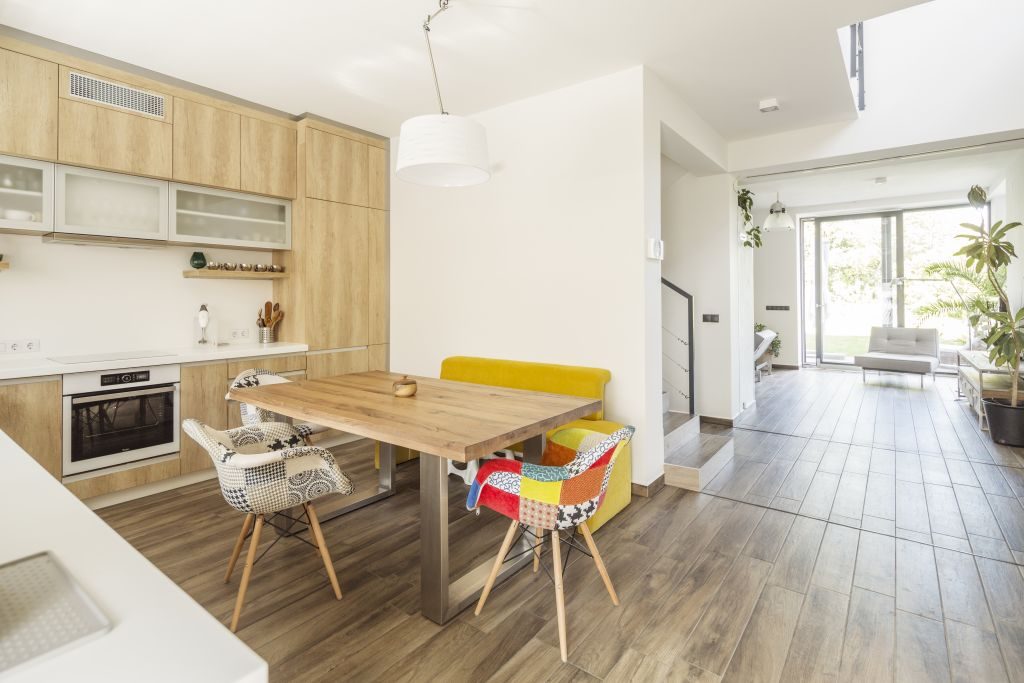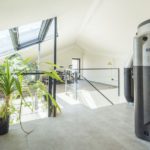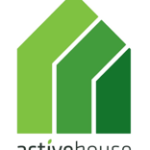Reborn Home

The garage is not conditioned, only the house is heated/cooled. In order to achieve optimal daylighting conditions in every part of the interior, a south oriented solar chimney with large glass curtain wall and glass roof was integrated into the building envelope. In this way the central, darker spaces perform also high level of visual comfort. The external, 36 cm thick eco-wood fibre thermal insulation and external shaded 3 pane glazing in windows deliver high thermal comfort in combination with radiative surface floor, ceiling and wall heating/cooling. A healthy tempering system, whereby indoor plastering is made of thermal activated 100% natural adobe (ceiling and wall heating/cooling) that manage heat and moisture balance of the interior efficiently. So thermal comfort is complemented by “humidity comfort”, a decisive factor of integral “multi-comfort”. The facades are covered with 100% natural timber clocking. Mechanical ventilation with heat recovery keep optimized VOC and relative humidity level of indoor air quality. In summer, natural night ventilation means passive comfort-cooling for thermal mass and interior.

First step of reaching high efficiency was to use the existing thermal mass of the building structures. The existing 30 cm thick brick wall was complemented with 3 pane glazing, external shading, external 36 cm wood fibre insulation and internal adobe plaster, that heats and cools the building. Two 100 m deep geothermal earth probes deliver heat for a heat pump (COP 4.5) in winter. In summer the approx. 15 ℃ of the brine water cools the building in a passive way (summer EER approx. 20!). In winter heat recovery is applied with 95% efficiency in the air handling unit, equipped with a 30 m long earth-soil heat exchanger that preheats (antifreeze protection) in winter and precools in hot summer periods supply air. Approx. 6-7 months can be natural ventilated, night cooled by ventilation. The heat pump produces DHW in winter (6 months) but in summer (6 months) a solar thermal vacuum collector provides 100% DHW. 1000 l hot water tank and 875 l cool water tank ensure high efficiency in heating-cooling by storing energy. The existing roof contained toxic asbestos, so a new roof was necessary: south and north oriented roof surfaces were designed with diagonal ridge and 27º, the optimal slope for the location to achieve maximum yearly yield of solar electricity by 3,5 kWp polycrystalline PV-system. Primary energy consumption in winter was 22,82 kWh/m2a (savings 70% to old version). In summer DHW was produced by solar energy, and AHU was not needed to use, since in extreme hot summer days inside was 10-15 K cooler than outside. A smart building management system monitors (for research purposes at University of Pécs) and controls heating, cooling, mechanical and natural ventilation, DHW and vacuum collector to minimize energy consumption.
A significant fact in LCA of the project is reusing as much structures and materials in existing building as possible. In this way almost 100% of the load bearing structure could be preserved, only new window position and geometry as well as the new gallery-solar chimney generated some formal changes. The existing reinforced concrete slabs and brick walls were completed by 100% natural adobe plaster, 100% natural wood fibre insulation, tile floor coverage (partly recycled) and 100% natural reed insulation (only garage). Existing, old toxic materials, as asbestos roofing and high radon radiant slab fill were replaced by metal roofing and insulation in slabs. A traditional combined Finn and Russian masonry heater made of reused bricks ensures backing and heating in ground floor as well as DHW in case of power outage. A previously water damaged wall part was refurbished with bio-plastering that dries out the wall. A 27 m3 special water cleaner rainwater cistern collets water from the roof. Rainwater is used to wash, to shower and to bath. By using a reversed osmosis water filter technology rainwater is also used to cook and to drink.




















